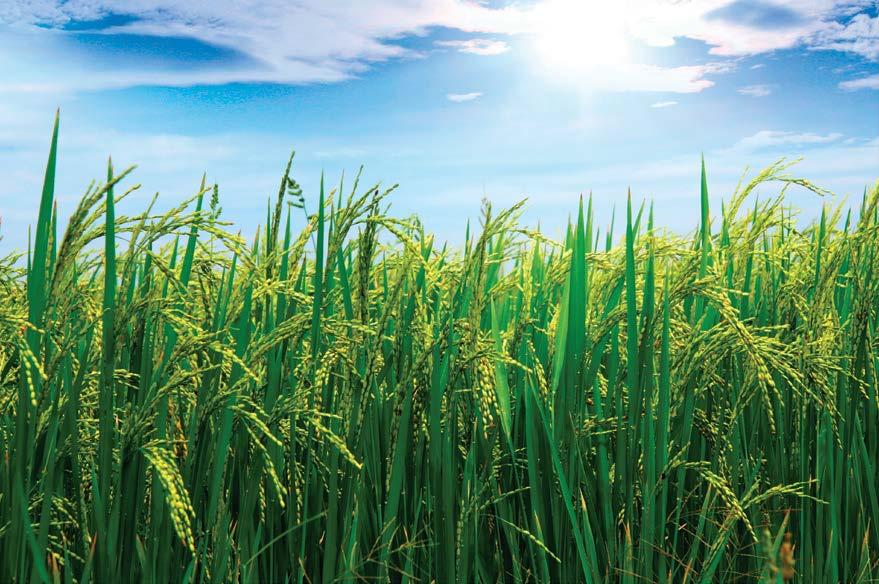
17 minute read
Ralston Rice in Demand
Arkansas Family Farm Expands Into Chinese Markets
While Robin and Tim Ralston were thrilled when their two adult daughters wanted to change careers in 2017 and join their parents and brother at the farm, they knew changes would be necessary for the operation to support additional partners. Those changes led to the development of a vertically integrated, farm to fork, agricultural operation that provided the first rice from Arkansas to be exported to China in July 2021.
Advertisement
The Ralston family has been farming for over ten generations, with the latest generation overseeing a diversified operation producing cattle, soybeans, and rice on 5,800 acres in the Arkansas River Valley near Atkins. Robin and Tim had been discussing the need for a value-added component for the farm, possibly a rice mill, for several years, but their daughters’ decisions to return to the farm accelerated their efforts. The Ralstons pitched their idea of growing and milling specialty rice on the farm to the University of Arkansas System Division of Agriculture and Ben E. Keith Company to help determine feasibility. After receiving a favorable response, they began working with Dr. Anna McClung, Director and Research Leader of the Dale Bumpers National Rice Research Center within the U. S. Department of Agriculture’s Agricultural Research Service, to gain insight on artisanal rice varieties. After much research, trial and error, construction of a state-of-the-art mill, mountains of paperwork, countless meetings, and a lot of prayers, Ralston Family Farms launched its unique offerings of specialty rice varieties in January of 2018.
Robin Ralston said, “Had we known at the beginning exactly what was involved, I’m not sure we would have done it, but now that we are here, we are grateful to all that made it possible. We are humbled to be stewards of what we believe to be among the very best rice available while utilizing farming practices that protect our land, water, and fossil fuels.” Ralston Family Farms is vertically integrated, meaning they control their product from the seed placed in the ground to the package that is placed on the shelf. Because Ralston Family Farms only mills and packages rice they grow, they can offer customers 100 percent traceability, which sets them apart. This traceability is one of the primary reasons a private importer in China contacted them about selling the product in grocery stores in China.
Although China is the world’s largest producer, consumer, and importer of rice, it remained closed to U.S. rice imports until the U.S. and China signed a Phase 1 Economic and Trade Agreement in January 2020 that expanded the potential for access to China’s rice market. This trade agreement was the result of more than a decade of efforts by the U.S. rice industry to establish a two-way trading relationship with China.
The first shipment of the Ralston's rice arrived in China in July 2021 and is being sold on the retail market under the Ralston Family Farm label. Retail demand in China for the products has been strong, and future shipments are in process. Exports to the United Kingdom are also being negotiated.
Regarding their initial sale to China, Ralston said, “We are honored to know that the product we have devoted our lives to at Ralston Family Farms will be shared across the world. We hope it benefits the entire U.S. rice industry and is just the first of many sales of U.S. rice into China.” In the U.S., the brand is available in over 6,000 retail supermarkets. Rice grits, a new product from Ralston Family Farms, hit store shelves in 2021 and is proving to be popular.
“Our family is committed to providing the very best products possible and we want the consumer to have confidence in our products from start to finish,” said Ralston. “Consumers can find a wealth of information about us, our farm, and our products, including recipes and cooking tips, at our website, ralstonfamilyfarms.com.”
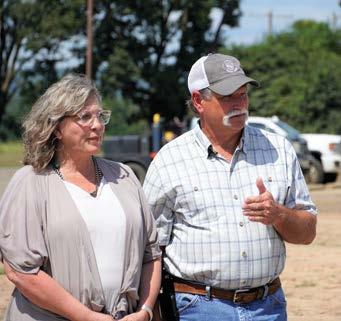

Proactive and Prepared
Strong Partnerships Help Protect Arkansas's Forests
They are dramatic scenes that unfold on a yearly basis in the American West – colossal blazes engulf large expanses of land while firefighters make heroic efforts to save communities. For Arkansans, forest fires feel like a foreign experience as they are not what would be considered a pressing danger. Yet, with a large portion of the state covered by abundant forests, one might wonder why there are not large blazes in the forests of the Ouachita Mountains, the Ozarks, and the West Gulf Coastal Plains of Arkansas.
“There are several reasons why Arkansas does not have the type of blazes that are seen in western states,” said State Forester Joe Fox, Arkansas Department of Agriculture's Forestry Division Director. “These include climate, tree species composition, ecosystem, and cultural approach to forest fires.” An obvious difference between the South and the West is climate. Arkansas is in an area of high humidity, which is in stark contrast to the dryer climate of many western areas. Further, Arkansas has consistent yearly precipitation while many western states have longer dry seasons, making them more susceptible to drought. The wind speeds in the western states are also higher, a significant contributor towards forest fires that can get out of control. There is also a unique shared culture of forest management in the South that takes a more proactive approach when it comes to the prevention of forest fires. This includes minimizing the conditions in which forest fires can occur, using techniques such as prescribed burns and thinning of wood products in forests. This shared culture of forest management is present in Arkansas as partnerships within the state that include a wide array of organizations.
“In Arkansas, we have strong partnerships in the forestry community between public and private landowners, loggers, industry, nongovernmental organizations, and state and federal agencies,” said Fox. “All agree that the best prevention for wildfire is good forest management practices on the ground over the forested landscapes.” Yet, when a wildfire does break out, having experienced firefighting professionals is crucial in keeping fires contained and extinguished. Currently, Arkansas has over 200 firefighters trained at battling wildfires, many of them with experience battling larger blazes in western states.
Mike Mowery, air operations branch director and county forester with the Forestry Division, is one of the many seasoned professionals in Arkansas, possessing over four decades of firefighting experience that includes assisting with blazes in several states. It was in Idaho that the Mountain View native cut his teeth, assisting with a blaze in the Salmon National Forest. As he found out during this campaign, there were numerous skills needed on a fire crew. When his team needed someone to manage radio dispatch at a helibase, Mowery jumped at the opportunity to add a skill to his wheelhouse.
“I had never been on a helibase before or worked radio communications,” said Mowery. “Now that I’ve gone through the system and managed it, I realized the radio operator is probably one of the most important jobs in fighting forest fires.” “As firefighters progress though their careers, new courses are required, which build upon the previous courses that were taken,” said Robert Murphy, emergency service director with the Forestry Division. “They also cater to different disciplines within the fire service, and whether it is operations, logistics, or planning, there are courses specifically designed to equip individuals with the tools necessary to be successful.” To say that Arkansas is immune to the large forest fires would be a misrepresentation of the situation. Though there are inherent advantages, Arkansas’s forestry community is taking the necessary steps in the prevention of wildfires while offering firefighters the training and resources that are crucial in staying vigilant against these types of blazes.
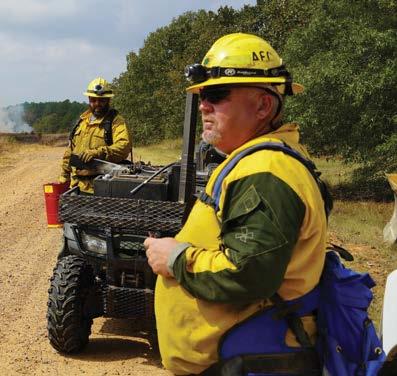
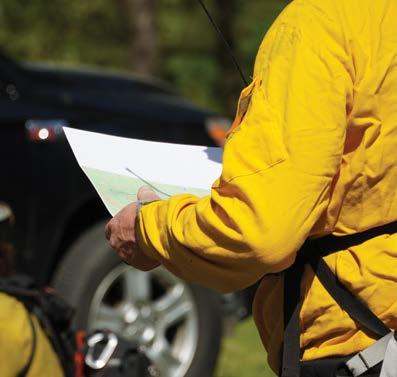
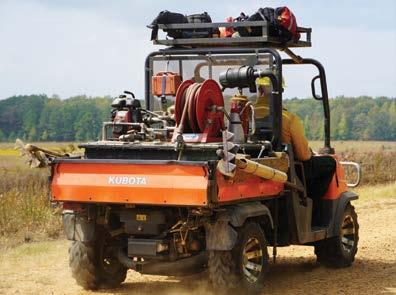
Busy People Get the Job Done
Mid-South Farm & Gin Show Enters Its 70th Year
It is widely understood that if you want something done, ask a busy person to do it. Sam E. Angel II is a busy person who gets a lot done.
Raised to see the value in giving back, Angel lives by that belief and has seen others step up when things need to happen in his lifelong home of Lake Village. The Angel family has a deep-rooted heritage in the Delta. Family patriarch Sam Epstein arrived in the United States as an immigrant from Russia in the 1880s. Epstein opened a dry goods store on Main Street and began purchasing land, overcoming poverty, and becoming one of Chicot County's most respected citizens.
Farmer and manager of Epstein Cotton Gin, Angel served on the Lake Village City Council and was elected to the Arkansas House of Representatives for six years. Lake Village Fire Chief, Captain of the Chicot County Sheriff’s Reserve, Board Chairman of the Chicot County Memorial Medical Center, Board Member of Agricultural Council of Arkansas, former Arkansas Rural Development Commission chairman, and chairman of the Arkansas Agriculture Board, Angel is now serving as the 2021 president of the Southern Cotton Ginners Association (SCGA).
Tim Price, Executive Director of the SCGA said, “Sammy embodies the best of several worlds; he has a great sense and appreciation of history, yet seeks out new ideas and innovations, understanding the critical need for technology adoption in a globally competitive world. Sammy has an in-depth knowledge of agriculture, while also understanding the broader world it operates in – from economics to politics, from being involved in the local community to the interconnectivity of global competition and customers. At SCGA, we had an ideal President for this last year, helping us deal with the COVID-19 challenges along with the tremendous pressures of supply-chain issues and changes in our industry.” The Southern Cotton Ginners Association is a non-profit organization founded in 1967. The mission of SCGA is to support and advance the educational, scientific, civic, commercial, and business interests of its members and allied industry associations and organizations.
The Cotton Ginners Associations of Arkansas, Louisiana, Mississippi, Missouri, and Tennessee, assemble to create the Southern Cotton Ginners Association, representing well over 95 percent of the total number of cotton gins in the Mid-South region.
The SCGA focuses on the safety of gin employees, research to enhance the quality of the product, and hosting the Mid-South Farm & Gin Show.
The Mid-South Farm & Gin Show, now in its 70th year, is a free indoor event that hosts approximately 400 exhibitors from over 30 states. Vendors and exhibitors from all niches of the agriculture industry showcase the latest innovations and technology in agriculture-related products and services. From displays of massive equipment to research on the tiniest seed, “The Gin Show” provides educational opportunities for anyone involved in or interested in agriculture. A spectacular non-profit event, attendees of “The Gin Show” travel from more than 15 countries to experience the weekend festivities. The longtime traditional show has adapted to COVID-19 challenges and now hosts both an inperson and virtual event accessible through the website and app.
In 2019, Arkansas ranked fourth in the nation in upland cotton and cottonseed. Leadership in this vital commodity crop is crucial to the state's economy. Angel has a steadfast family history and an enthusiasm for innovation. His leadership in the Southern Cotton Ginners Association and Arkansas agriculture benefits the entire industry. Information about the 70th Annual Mid-South Farm & Gin show is available at https://www. farmandginshow.com/.
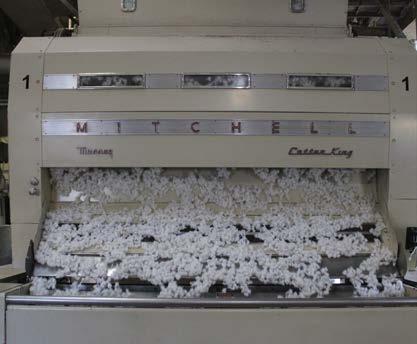


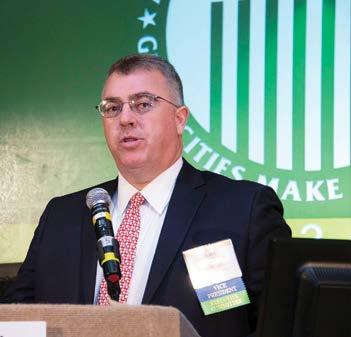
Telling Their Story
Farmers Find Success with Marketing in a Changing Marketplace
Here in the dawn of the 21st Century, the agriculture industry is witnessing an unprecedented integration of technological advancements that have given rise to the boom in Precision Agriculture. In recent years, the ag industry has pioneered the application of drone technology, data collection and analysis, and electronic identification to achieve streamlined logistical efficiency in the world’s safest food supply chain. While the agriculture industry has come a long way in the last 50 years, it feels at times that our communication efforts haven’t. The ag industry has been slow to recognize the importance of being a proactive participant in telling their unique story to consumers. This has created an uphill battle for the ag industry as it reacts to the ongoing spread of misinformation and distrust in the market. As an industry and as individuals, it’s more important than ever for farmers to have a voice in the agriculture business story.
More organizations in the industry are starting to realize how their business challenges can be effectively met with the right communications and marketing strategy. The Arkansas Boll Weevil Eradication Program (ABWEP) is a great example of that success. Two years ago, the organization had no digital presence at all and conducted business in much the same way it did in 1997 – until ABWEP Executive Director Regina Coleman had a lightbulb moment that has since enhanced the Arkansas cotton industry.
Today, ABWEP has modern branding, a state-of-the-art website complete with reliable online business tools for growers, consistently active social media channels, and a custom e-newsletter that function in concert with a strategic communications plan custom-created to give the Arkansas Boll Weevil Eradication Program an authoritative voice in the market.
ABWEP relied on a collaborative partnership with their communications agency to build a strategic communications plan that gave the organization presence and credibility in the evolving agriculture narrative. In a matter of months, ABWEP has undergone a transformation from being virtually invisible to establishing a position of leadership among its sister organizations across the Cotton Belt.
Other organizations in the state such as the Arkansas Soybean Promotion Board and Arkansas Corn & Sorghum Board have also benefitted from having a clear voice with their stakeholders.
Carson Horn, APR, is the farm-raised director of public relations and the resident ag industry expert at The Communications Group, a Little Rock-based marketing and public relations firm specializing in agriculture and manufacturing. Horn says the root of a company’s success lies not just in the quality of its product or service, but is linked closely with its ability to build a marketing strategy that helps the company define its voice and protect its brand in an increasingly crowded marketplace.
“There are two ways for people to learn about your business – from someone else or from you. You can have the best product in the world, but if no one knows about it, or if they have incorrect information they’ve gotten from someone else, you’ll constantly be challenged to find sales success,” Horn remarked. “All too often, people make the mistake of fixating on the perceived cost of effective marketing and communication. Instead, marketing and strategic communications should be treated as an investment with the expectation of a return.” What many agribusinesses don’t realize, Horn says, is that marketing is not a one-size-fits-all proposition. In Horn’s experience, businesses often have the perception their marketing plans have to be complex and multifaceted in order to be successful. This notion can overwhelm businesses and marketing managers or deter them from exploring their options altogether. Horn suggests taking a more moderate approach in developing marketing plans that address specific challenges – and grow from there.
“In many cases, clients discover that their goals can be achieved through less intensive and more costeffective means that ultimately reap all the reward but save them from making larger than necessary investments,” Horn said. “When we work with agriculture clients, our goal is to craft a plan that addresses their unique needs, and every ag client is different.” Technology and trends continue to rapidly change. Whether it’s a large corporation or a small family farm, Horn advises businesses and organizations of all sizes to commit to investing in an effective marketing plan that will help create, support, and grow share of market and share of voice.
Effective marketing ensures sustainable longterm growth and success. To help agribusinesses make informed decisions about their marketing strategies, The Communications Group released an Ag Industry Insights report outlining the top marketing trends to consider in 2022. Horn concludes that while this report can certainly help determine some of your strategic priorities, a good marketing plan starts as it often does on the farm, with a tiny seed that eventually grows into something good for the world.
To review The Communications Group’s complete 2022 Ag Industry Insights report, visit ComGroup.com.
The Communications Group’s Top Ag Industry Marketing Trends in 2022
1. Increased Customer Focus 2. Modernization 3. Data-based Decision Making 4. Visual Branding
5. Selective Audience Building 6. Intentional Communication 7. Multichannel Marketing 8. Content Consistency 9. Thought Leadership 10. Strategic Partnerships
The Communications GroupWe can’t wear our office shoes indoors.The Communications Group
COMMUNICATIONS GROUPAgriculture is different. We get that. We get it, because we are a part of it. The Communications Group has served ag industry clients for more than 30 years with a dedicated Ag Marketing Team. Our Ag Marketing Team makes The Communications Group unique. That uniqueness is our personal backgrounds. The members of our ag team represent multiple generations of ag families. From crops to cattle to poultry, some of us grew up with farming. We know that farming is more than an ad…it’s a frame of mind and a lifestyle. So, what line of work are you in? Poultry? Livestock? Industry Association? Equipment Manufacturing? Commodities? We’re in the ag business. No matter what your business needs are, The Communications Group specializes in agriculture. Start a conversation today with our ag industry experts to learn how The Communications Group can help you by visiting ComGroup.com.
| MarketingOMMUNICATIONS GROUP because we are a part of it. The Communications Group has served ag industry clients for more than | Communications 30 years with a dedicated Ag Marketing Team. Our | Public Relations Ag Marketing Team makes The Communications Group unique. That uniqueness is our personal | Advertising backgrounds. The members of our ag team | Websites represent multiple generations of ag families. From crops to cattle to poultry, some of us grew | Social Media up with farming. We know that farming is more | Brand Development + Logos than an ad…it’s a frame of mind and a lifestyle. | Creative Development So, what line of work are you in? Poultry? Livestock? And More! Industry Association? Equipment Manufacturing? Commodities? We’re in the ag business. No matter what your business needs are, The Communications Group specializes in agriculture. Start a conversation today with our ag industry experts to learn how The Communications Group can help you by visiting ComGroup.com. | Marketing | Communications | Public Relations | Advertising | Websites | Social Media | Brand Development + Logos | Creative Development And More!
Visit ComGroup.com for a FREE Website or Social Media Audit. Visit ComGroup.com for a FREE Website or Social Media Audit.


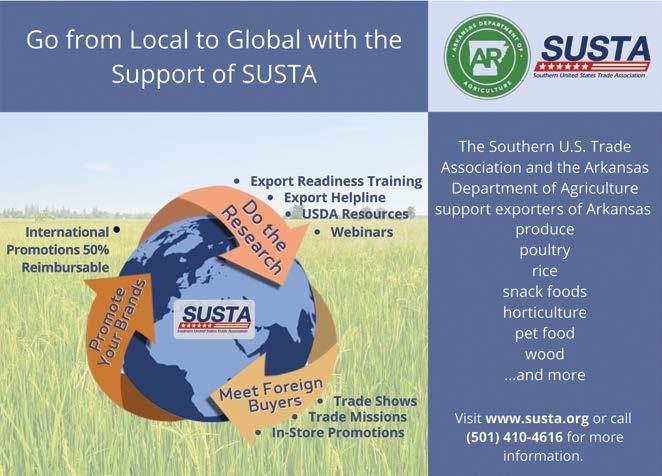
Advertising Directory
Arkansas State University Arkansas Farm Bureau
Simmons Bank
FarmVoice
The Poultry Federation Arkansas Corn & Grain Sorghum Board Arkansas Timber Producers Association Arkansas Interfaith Power & Light Cross, Gunter, Witherspoon & Galchus, P.C. Catfish Farmers of Arkansas Arkansas Women in Agriculture Arkansas Soybean Promotion Board Farm and Ranch Stress Assistance Network Arkansas Cattlemen's Association Arkansas Forestry Association
Arkansas Beef Council
Arkansas Association of Conservation Districts Heritage Agriculture of Arkansas
First Financial Bank
SASDA
Agricultural Council of Arkansas
The Communications Group Arkansas Peanut Growers Association Southern United States Trade Association
i ii iii 2 6 8 25 28 33 33 37 41 49 54 64 64 65 65 89 90 94 99 108 109 109 111 112
